DNA Casework
The DNA Casework section of the Missouri State Highway Patrol (MSHP) Crime Laboratory works criminal cases involving homicide, sexual assault, burglary, assault, missing persons, as well as other types of crimes. The section is assigned the tasks of locating and identifying biological fluids and obtaining DNA (deoxyribonucleic acid) profiles from crime scene evidence.
Law enforcement agencies throughout the State of Missouri submit crime scene evidence to the laboratory. When appropriate, the DNA analysts search for and identify semen and human blood using a combination of presumptive (the body fluid is possibly present) and confirmatory tests (the body fluid is present). Following the examinations for blood or semen, the analysts attempt to develop a DNA profile from the evidence item. Although DNA is present in saliva, vaginal secretions, and skin cells, the DNA analysts cannot test for or identify these sample types.
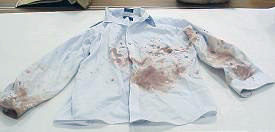
A shirt with red-brown staining would be further tested with presumptive blood tests.
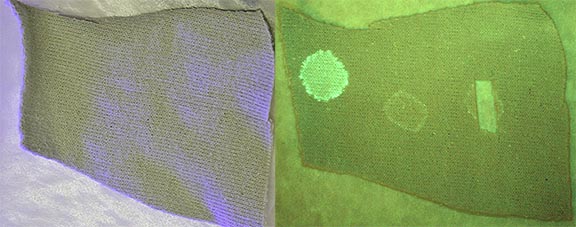
- Left: sweatshirt fabric under normal light
- Right: sweatshirt fabric under the alternate light source
- Stains on a sweatshirt visualized with an alternate light source become visible and are tested further with presumptive and confirmatory semen tests.
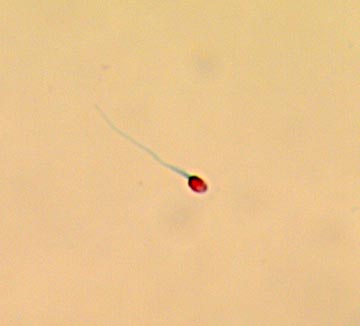
- The confirmatory test for semen uses the microscope to visualize sperm cells with the sperm head stained red and the tail stained green.
The analysis of DNA is often an essential tool in forensic examination of crime scene evidence. The MSHP Crime Laboratory began using the Polymerase Chain Reaction (PCR) in 1995. And shortly after starting the use of PCR, it was applied to the analysis of short tandem repeats (STRs), which began in 1999 and continues today. PCR, in conjunction with STR analysis, allows for DNA profiles to be developed from challenging DNA samples The laboratory has had success processing a variety of sample types, including samples with low quantities of DNA, as well as samples that have been subjected to harsh conditions such as decomposition.
Additionally, the laboratory began the use of Y-STR technology in 2005. Y-STR analysis is specific to the Y chromosome found only in male individuals and may be beneficial when small quantities of male DNA are present amidst large quantities of female DNA. This scenario can be common in sexual assault scenarios, particularly when sperm cells are not present or when there has been an extended time interval between the assault and the collection of evidence. The limitation of Y chromosome testing is that it cannot identify a specific individual because it is inherited through the paternal blood line, unchanged from generation to generation. Therefore, one can expect that a male individual’s father, brother, grandfather, son, paternal uncle, paternal nephew, etc. will all have the same Y-STR profile. Y-STR testing is, however, useful in instances when traditional STR analysis has not been successful.
In order to develop a DNA profile from an item of evidence, four basic steps are used. The first step in the process is called extraction. Extraction involves breaking open the cells found in the sample and purifying the DNA found inside. Typically, this process involves the use of a robotic instrument that automates and speeds the process. The next stage in the process, quantification, is used to determine the quantity of human DNA present in each sample. The current quantification process also can assess whether there might be a male individual contributing DNA to the sample, and whether there is a possibility the sample is degraded. The third step in DNA analysis is amplification, which is performed by utilizing PCR and a targeted quantity of DNA. During this procedure, STR genetic locations across most of the 23 chromosomes (to include the X and Y chromosomes) are targeted and copied millions of times. The final phase of developing a DNA profile is separation and detection/analysis. This step uses a genetic analyzer to generate a DNA profile by performing capillary electrophoresis to separate and detect the amplified DNA molecules and computer equipment to analyze the results.
- The interior of a Maxwell® 16 Forensic Instrument
- The Maxwell® 16 is a robotic instrument that automates the DNA extraction process for 16 DNA samples at a time.
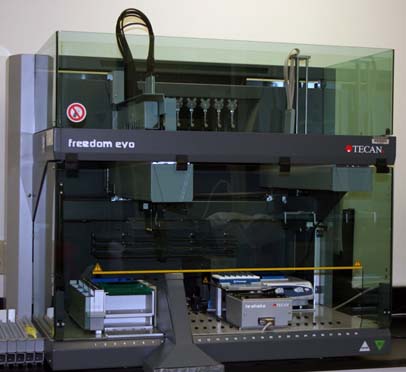
- The TECAN Freedom EVO® is a liquid handling system to automate and speed processes involved in DNA analysis allowing the DNA analyst to perform other tasks instead of completing the set-up manually.
The 7500 Real-Time PCR System is used to perform quantification, the second step in DNA analysis.
The 3500 Genetic Analyzer contains eight capillaries allowing for the simultaneous analysis of eight DNA samples.
After the steps of DNA analysis are completed in the laboratory, the DNA analyst will compare the DNA profile developed from an item of evidence to the DNA profile developed from a known reference sample. A known reference sample is typically a swab from the interior cheek of an individual (buccal swab) or a blood sample in a purple cap tube; either can be used to develop a reference profile. An evidence profile is either from a single individual (single source profile) or from multiple individuals (mixture profile). The reference standard profile is used to determine if it is a match to the single source evidence profile, a contributor to the mixture profile, and/or if the person is excluded. If the DNA sample is of poor quality or is a complex mixture, this may prevent any conclusions being made regarding the presence or absence of an individual.
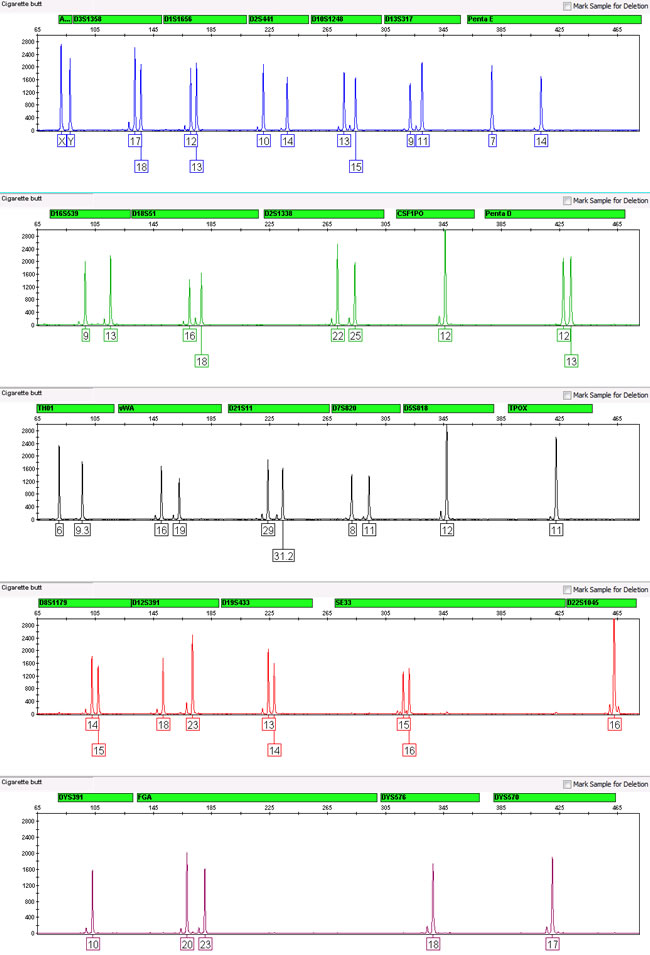
A complete male DNA profile with information present at each of the genetic locations tested.
A comparison of two separate DNA profiles that match at every genetic location tested.
The DNA casework section also participates in the Combined DNA Index System (CODIS). It is composed of local, state, and national DNA databases that combined contain millions of DNA profiles including those from convicted offenders, crime scenes, unidentified human remains, and relatives of missing persons. The CODIS database enables local, state, and national crime laboratories to compare DNA profiles electronically. These comparisons aid in the identification of previously unknown perpetrators and connecting multiple crimes across or within jurisdictions to a single individual.